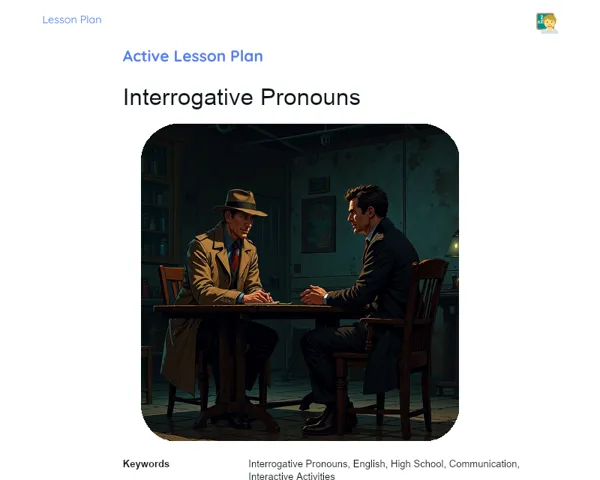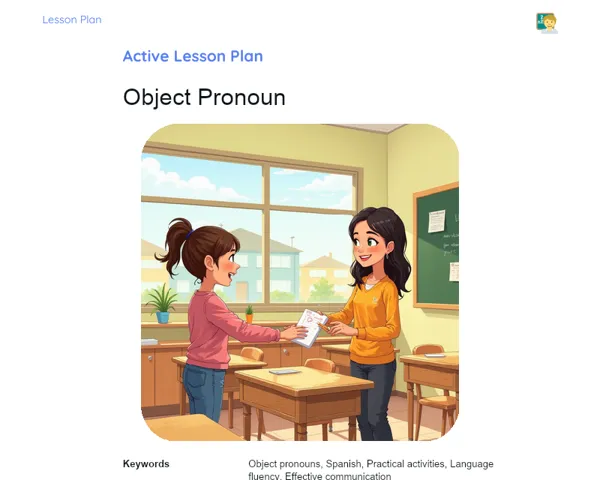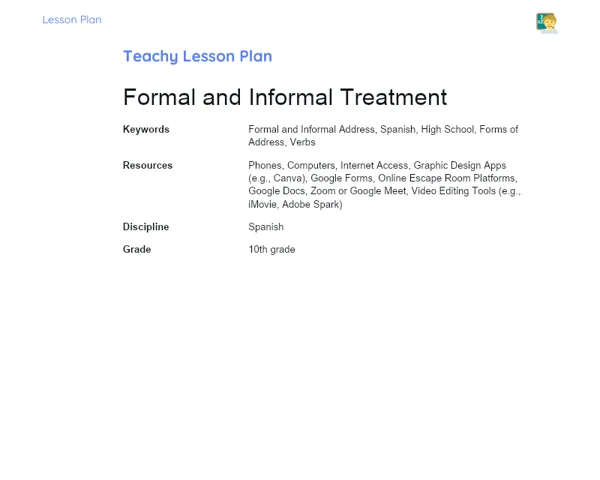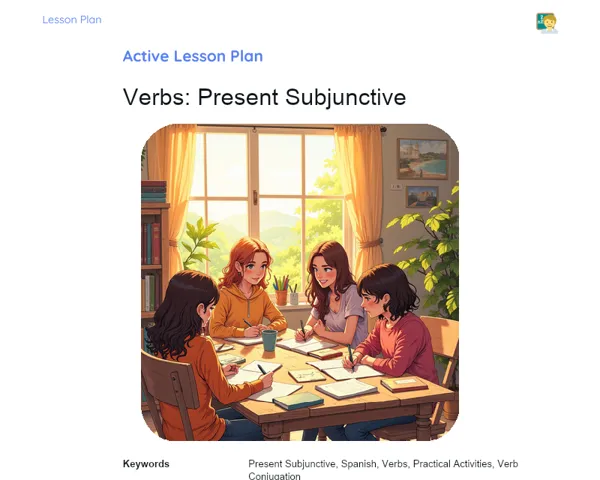Lesson Plan | Lesson Plan Tradisional | Verbs: Periphrastic Future
| Keywords | Future Verbal Periphrase, Verbs, Simple Future, Conjugation, Contexts of Use, Practical Exercises, Text Interpretation, Expressing Plans, Predictions, Promises, Spanish, High School |
| Resources | Whiteboard, Markers, Projector, Presentation Slides, Exercise Sheets, Reading Texts, Pens, Students' Notebooks |
Objectives
Duration: (10 - 15 minutes)
The aim of this section is to give a clear overview of the lesson's objectives, outlining the key skills students should develop. This guidance helps both educators and learners stay aligned on the lesson's focus, ensuring everyone understands the significance and practical application of the content covered.
Objectives Utama:
1. Understand the structure and use of future verbal periphrases in Spanish.
2. Identify and correctly use future verbs in various contexts.
3. Develop the ability to interpret texts in Spanish with a focus on expressing the future.
Introduction
Duration: (10 - 15 minutes)
This part sets up the students with an understanding of the importance of future verbal periphrases, linking grammar with practical application. This creates an engaging learning atmosphere and piques students' interest from the outset of the lesson.
Did you know?
Did you know that, in Spanish, the most common way to discuss the future isn’t the simple future tense, but rather the construction 'ir a + infinitive'? Instead of saying 'Yo estudiaré' (I will study), you’re more likely to hear 'Yo voy a estudiar' (I am going to study). This form is widely known in everyday chat and shows how the language evolves to meet its speakers' communication needs.
Contextualization
To kick off the lesson, highlight that verbs are a dynamic and essential part of any language, Spanish included. The future verbal periphrase is a structure that allows speakers to articulate actions that will happen later. Knowing how to use this is crucial for effective communication and for grasping Spanish texts. The future verbal periphrase is especially handy in scenarios where something is anticipated, planned, or promised.
Concepts
Duration: (50 - 60 minutes)
This section offers a detailed, practical understanding of future verbal periphrases in Spanish. By exploring the structure, conjugation, and contexts of use with practical examples, students will confidently identify and apply these constructions in their communication. The accompanying questions are designed to reinforce learning and encourage active engagement with content in real-life situations alongside establishing comparisons with other verb tenses.
Relevant Topics
1. Future Verbal Periphrase: Structure and Use: Explain that in Spanish, the future verbal periphrase is formed by conjugating the verb 'ir' in the present indicative followed by the preposition 'a' and the main verb in the infinitive. For example: 'Yo voy a estudiar'.
2. Difference Between Simple Future and Future Periphrase: Clarify the distinctions between the simple future (synthetic future) and the future verbal periphrase. Indicate that the simple future (e.g., 'estudiaré') is less prevalent in everyday dialogue, being more suited to formal or written contexts.
3. Contexts of Use: Discuss the situations where the future verbal periphrase is most suitable, such as promises, plans, predictions, and intentions with clear examples for each scenario.
4. Conjugation of the Verb 'Ir': Go over how to conjugate 'ir' in the present indicative (yo voy, tú vas, él/ella va, nosotros vamos, vosotros vais, ellos/ellas van).
5. Practical Examples and Exercises: Show sentences and brief texts that use the future verbal periphrase, prompting students to identify and explain the use of this structure in each example.
To Reinforce Learning
1. 1. Write three sentences using the future verbal periphrase to express plans for next weekend.
2. 2. Compare and contrast the use of the simple future and the future verbal periphrase in Spanish with examples for each.
3. 3. Read the provided paragraph and identify all instances of future verbal periphrases. Explain the context of each.
Feedback
Duration: (15 - 20 minutes)
This part is crucial for reviewing and cementing the knowledge gained throughout the lesson, creating a space for students to discuss their responses and reflections. This not only bolsters their grasp of future verbal periphrases but also fosters active engagement and critical thinking among students.
Diskusi Concepts
1. ✅ Question 1: Write three sentences using the future verbal periphrase to express plans for next weekend. 2. Clarify that responses should follow the 'ir a + infinitive' format. Possible answers might include: 3. Yo voy a estudiar para el examen de matemáticas. 4. Tú vas a visitar a tus abuelos en el countryside. 5. Nosotros vamos a ver una película en el cine. 6. ✅ Question 2: Compare and contrast the use of the simple future and the future verbal periphrase in Spanish with examples for each. 7. Indicate that the simple future is mainly seen in formal writing, while the periphrase flourishes in everyday talk. Examples: 8. Simple Future: 'Ella estudiará medicina en la universidad.' 9. Future Verbal Periphrase: 'Ella va a estudiar medicina en la universidad.' 10. ✅ Question 3: Read the provided paragraph and identify all of the future verbal periphrases. Explain the context of each. 11. Offer examples of how to spot future verbal periphrases and outline their contextual application. Example paragraph: 12. 'Mañana vamos a visitar a nuestros abuelos y después vamos a comer en un restaurante.' 13. Clarify that 'vamos a visitar' signals a planned action for the near future, and 'vamos a comer' also indicates a scheduled event.
Engaging Students
1. ❓ Question 1: Why do you think the future verbal periphrase is more common in everyday Spanish conversation? 2. ❓ Question 2: How would you decide when to use the simple future versus the future verbal periphrase in formal writing? 3. ❓ Question 3: Can you share an example from your life where you would use the future verbal periphrase? 4. ❓ Reflection: How does understanding future verbal periphrases aid in reading and interpreting Spanish texts?
Conclusion
Duration: (10 - 15 minutes)
The goal of this phase is to revisit and solidify the knowledge gained during the lesson, providing a concise summary of key points while underscoring the practical relevance of the material. This ensures that students leave the session with a solid and usable grasp of the topic discussed.
Summary
["The future verbal periphrase in Spanish is constructed by conjugating 'ir' in the present indicative followed by 'a' and the main verb in the infinitive.", 'Differences between the simple future (synthetic future) and the future verbal periphrase: the former is more frequently used in formal and written contexts, whereas the latter thrives in everyday conversations.', 'Contexts for the future verbal periphrase include promises, plans, predictions, and intentions.', "Conjugation of 'ir' in the present indicative: yo voy, tú vas, él/ella va, nosotros vamos, vosotros vais, ellos/ellas van.", 'Concrete examples of sentences and texts utilizing the future verbal periphrase.']
Connection
Throughout the lesson, it was illustrated how the theory behind future verbal periphrases finds practical application in forming promises, plans, and predictions. Practical examples and exercises enabled students to witness the tangible relevance of theory in daily Spanish discourse.
Theme Relevance
Understanding and correctly using future verbal periphrases is vital for clear communication in Spanish, especially in day-to-day situations involving planning and predictions. This knowledge not only streamlines both verbal and written expression but also enhances comprehension of Spanish texts, emerging as a valuable skill for learners.



